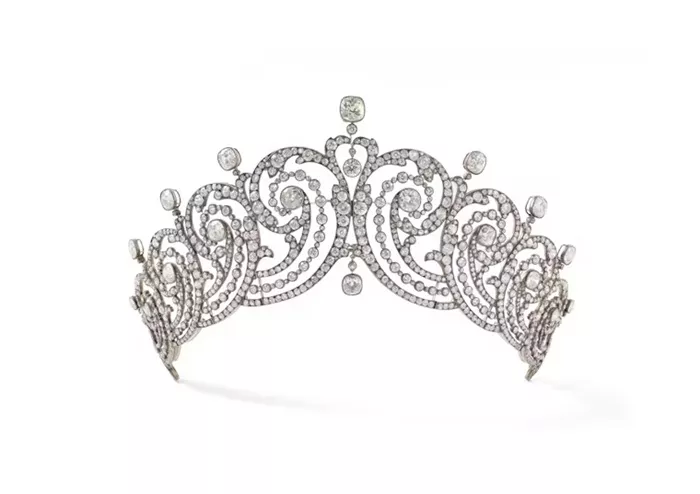A new exhibition at London’s Victoria and Albert Museum is putting the spotlight on Cartier’s rich history and legacy in fine jewelry. The final room of the show features 18 dazzling tiaras, including a never-before-seen opal piece commissioned by the Marchioness of Hartington and a striking Art Deco halo design once worn by Begum Aga Khan III.
But one tiara stands out before visitors even enter the main gallery. Displayed in a misty alcove, a gold and silver scroll-style tiara gleams with over 1,000 diamonds. Known today as the “Rihanna tiara,” it was originally made in 1902 for the Countess of Essex. In 1953, Prime Minister Winston Churchill’s wife wore it to Queen Elizabeth II’s coronation. Decades later, pop icon Rihanna brought it back into the spotlight on the cover of W magazine in 2016.
In that photoshoot, styled by Steven Klein, Rihanna wore the antique tiara with shimmering lips and gold tear-like makeup. She also wore a Cartier platinum and diamond collar from 1906, originally made for American heiress Mary Scott Townsend. For the first time, Cartier is showing both of these historic “Garland Style” pieces together in the same display.
“We wanted to capture the bold image of Rihanna wearing these antique jewels in a futuristic, diva-like way,” said exhibition cocurator Helen Molesworth. “It’s a brilliant example of how Cartier’s classic designs can be reimagined for modern times.”
The exhibition is divided into three main themes: Cartier’s history, craftsmanship (known as savoir faire), and its lasting influence. The show traces the brand’s roots back to 1847, when it was founded in Paris. It was the first major jeweler to treat precious stones not just as symbols of power for royalty, but also as fashionable statements for rising social classes like celebrities and socialites.
More than 350 items are on display, including jewelry, watches, and rare objects. The exhibition explains how Cartier’s founder’s three sons—Louis, Pierre, and Jacques—expanded the business to London and New York in the early 1900s. Their global clientele ranged from Indian royalty to American high society. Louis even married into the House of Worth and opened a studio in the same building as the famous Paris fashion house’s London location.
“That was a smart move,” said Molesworth. “It meant that wealthy women shopping for couture could buy Cartier jewelry at the same time.”
In 1925, Cartier made a bold statement at the International Exhibition of Modern Decorative and Industrial Arts in Paris—the event that launched the Art Deco movement. Instead of showcasing its work in the jewelry section, Cartier set up shop alongside fashion designers in the Pavillon of Elegance. One standout piece from that show was the Bérénice necklace, which had a 141-carat Colombian emerald carved in Mughal style. The emerald was later made into a brooch and eventually set into a tiara for businesswoman Pansy Ho in 2012.
The exhibition features many other rare jewels on loan. A 487-carat Sri Lankan sapphire from Qatar Museums is one of the most notable. Once owned by Queen Marie of Romania in 1921, it was the world’s largest at the time and still ranks among the top five.
Visitors can also see the Williamson diamond, a rare pink gem from the Royal Collection. Cartier designer Frederick Mew mounted it on a brooch for Queen Elizabeth II in 1953. The V&A, which holds Mew’s design archive, displays the original sketches of the piece with the Queen’s handwritten approval note.
Another highlight is Grace Kelly’s engagement ring. The step-cut diamond ring, loaned from the Monaco Princely Palace Collection, was featured in her last film High Society before she married Prince Rainier III.
Even Hollywood’s modern sparkle gets a nod. The Toussaint necklace worn by Anne Hathaway in the 2018 film Ocean’s 8 is also on display. Although the one in the movie was a cubic zirconia replica, the original necklace was a stunning Cartier design created in 1934 for the Maharaja of Nawanagar. It featured colored diamonds in pink, blue, and green, along with a flawless white diamond weighing 136.25 carats, which has since been lost.
The exhibition at the V&A Museum offers a rare look at Cartier’s timeless style, its iconic clients, and how its masterpieces continue to inspire new generations.
Related topics:
- Gold Prices Hit Record High, Boosting Jewellery and Bullion Sales
- Jewelry Factory Backed by Chinese Investment Opens in Dushanbe
- Burglars Steal Millions in Jewelry from Downtown Los Angeles Store


